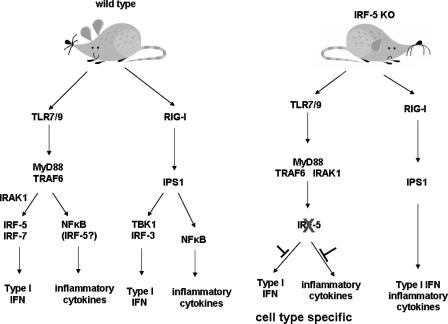FIGURE 7.
The role of IRF-5 in the innate antiviral response. Following infection, viral nuclei acids are recognized by membrane-bound TLR and cytoplasmic RIG-I/MDA5 receptors. Our data, in conjunction with data of others (32), have shown that IRF-5 is activated by TLR7- or TLR9-, MyD88-dependent pathway. Activated IRF-5 stimulates expression of IFNA and IFNB genes as well as the inflammatory cytokines. However, although the role of IRF-5 in the activation of type I IFN genes is restricted to the MyD88 pathway and to cells that express the TLR7 or TLR9 receptors, the activation of the inflammatory genes by TLR4 and TLR3 seems also to be dependent on IRF-5, and consequently the role of IRF-5 in the induction of these inflammatory cytokines is broader and less cell type-restricted. There is no evidence that IRF-5 plays a substantial, if any, role in the RigI, IPS1 (VISA/MAVS/CARDif) pathway, and whether it can be activated by the MAD5 pathways is yet to be determined.

